

The Pet Food Market in Hong Kong
15 MARCH 2000
Prepared by: EASE PUNDIT LIMITED
Rm 47, Blk F, 20/F., Wahlok Industrial Centre,
31-35 Shan Mei Street, Fotan, Nt, Honk Kong
Tel : + (852) 23955048
Fax : +(852) 23954922
E-mail : ezpundit@hkstar.com
Table of Contents
1.1 Market: Present and Past
1.2 Factors Affecting Growth
Rate
1.3 The Competitive Environment
1.4 The Canadian Position
1.5 Sub-Markets
2.1 Imports, Re-exports,
Domestic Exports
2.2 Local Demand Consumption
2.3 Market Share - By Food
Type
2.4 Major Brands
and Respective Market Shares
2.5 Market Share
- By Supplying Countries
3.1 Distribution Channel
3.2 Mark-up at Distribution
Stages
3.3 Pricing and Packaging
3.4 Recommendation
for Promotional Activities
4.1
Local Legal Requirements for Packaging
4.2 Consumer Preference
5.0 Consideration For Market Entry
5.1 Suggested Business Practices
5.2 Rules and Regulations
6.0 Pet Food Importers and Agents
Executive Summary
Hong Kong itself does not have its own pet food manufacturing industry. The Hong Kong pet food market is supplied solely by imports. The pet food business is very young in Hong Kong; it is less than 10 years old. This report is intended to provide a brief, detailed analysis of the Hong Kong market for pet food.
Pet food can be divided into five categories 1) Dog Food, 2) Cat Food, 3) Fish Food, 4) Bird Food and 5) Others. Based on value dog food presently dominates the overall pet food market and accounts for 54% of total pet food consumption. Cat food, in turn, represents an estimated 28%, while fish and bird feed make up a nominal 14% and 2% respectively. The remaining 2% consists of feed for a range of exotic pets such as turtles, lizards, snakes, hamsters and chinchillas.
It is estimated that in 1999, total pet food consumption in Hong Kong was valued at HK$146.60 millions, which represented approximately 16.60 million kilograms of all four categories of pet food combined.
The market for pet food is competitive and has declined over the last few years due to recent regulations on the restriction of pet ownership in public housing. An estimated 20% of pet owners have given up their pets since the enforcement of the regulations in 1996.
Although the majority of dogs and cats in Hong Kong are currently fed left over table's scraps, this trend is gradually changing toward pet food usage This change is primarily due to changes in the overall in Hong Kong lifestyle over the last 10 years.
Total consumption of pet food items is expected to growth of no more than 8 - 10% annually over the next five years. This increase is attributed to those young and single people in the middle class, in particular, who are purchasing pets as companions.
Dog and cat food make up 82% of the pet food market in Hong Kong, and all major brands are already strongly represented (Iams, Hill's Natures Recipe, Effem Food etc.). Most of the fish food sold in Hong Kong comes from Taiwan and Japan; they share 14% of the total pet food market.
According to discussions with several key players within the industry, average profit margins for importers of pet food items are approximately 15% and retailers 15 - 20%.
Companies wishing to export pet food products to Hong Kong should consider the following key points.
- As a significant percentage of dog and cat owners still regularly feed their pets table-left-overs, pet food companies need to educate buyers about the convenience and nutritional benefits derived from providing specialized pet food to feed their pets as opposed to table's scraps.
- Big sized dogs are in smaller numbers due to regulations and the limited living space in Hong Kong. Dog food can be specially prepared for small dogs to help in their development or developed for both cats and dogs.
- As pricing is expected to further reduced in the near future, profitability will be affected. Therefore, the report cautions that steps should be taken to further reduce cost and overhead expenditures.
Hong Kong is a free port and has a bustling free market economy with few tariffs or no tariff barriers. Imported pet food is free of restrictions, though there are labelling requirements for animal feed and pet food.
1.0 Market Overview
1.1 Market: Present and Past
Present
It is estimated that in 1999, total pet food consumption in Hong Kong was valued to HK$146.60 million, which represented approximately 16.60 million kilograms of the following four categories of pet food listed below:
- Dog Food
- Cat Food
- Fish Food
- Bird Food
- Others
The ratio of dog food versus cat food demand in Hong Kong is about 1 to 2, or 66% to 34%, and the ratio in the pet food market is 54% and 28% respectively, totaling 14.00 million kilograms.
Of the dog and cat food, the ratio of dry pellets versus canned wet food is about one to one.
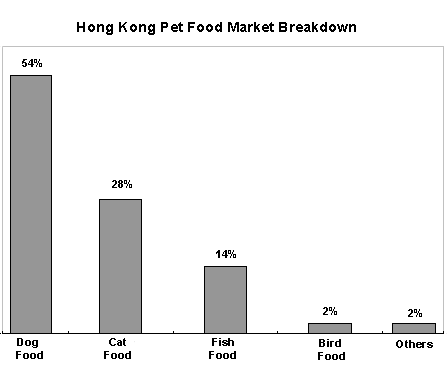

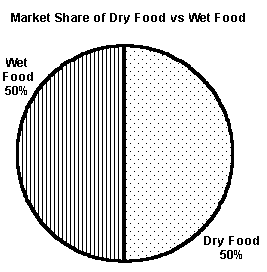
Source: Ease Pundit Limited
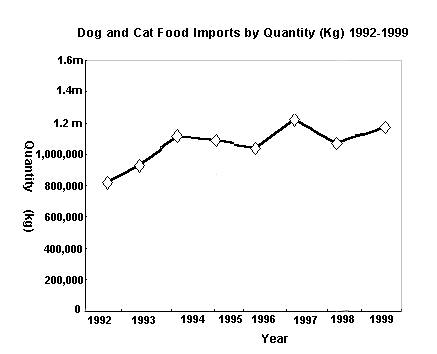
Source: HKCSD
Past
At the time 20 years ago, living standard did not easily support to have pet in family in Hong Kong. Pets in general have served a practical purpose; cats were used to control the rat population and dog primarily for protection of one's home and possessions. During the 1980's Hong Kong had an economic explosion, consumer's disposable income rose dramatically, which in turn allowed for purchase beyond daily necessities. As a result of this increased wealth, people began purchasing a variety of different types of pets as symbols of status and prestige. Purebred dogs in particular are considered to represent wealth and prosperity to Chinese, hence is the most popular type of pet to own. Some people are willing to pay a lot of money on pet to show off their property, which others cannot afford to have.
Imports of dog and cat food into Hong Kong grew at double digits annual average growth rate in early 1990's. Imports peaked in 1994, and declined at 5% each year since 1995. But, at 1997 had a growth in volume more than 1994, after that a tremendous drop down of 15% was followed in 1998, and a stabilized situation is kept to an average of 12,000 metric ton since then.
The decline was carried by Hong Kong Government's strict enforcement of policies controlling pet ownership. Dogs are already supposedly banned from public housing and most private residential developments. But this rule was rarely enforced the most since the control and there are thousands to flout it. 1996 was affected the most since the control and enforcement was then the strictest. Housing Authority has already pledged to write to all tenants, warning they will be evicted if they keep dogs. Same attitude adopt to cats and other small pets as it has to dog.
The decline was also a result of a decrease in re-export to other countries since 1996.
1997 saw a 25% increase compare with 1995 and 1996, it should be the enforcement slightly relaxed, and pet foods were increase again.
More than 10,000 dogs and cats were brought in to Society for Prevention of Cruelty to Animals (SPCA) during the second half of 1998, but homes were found for only 649 of them. During the same period of 1997, 721 of animals were placed. If homes cannot be found, the animals have to be put down. It caused the decrease of dog and cat food imports to Hong Kong at 1998.
1.2 Factors Affecting Growth Rate
The Hong Kong Government's strict enforcement of policies controlling pet ownership and the economic down trend since 1995, it consolidate the pet food market to be more stability in growth at the future. Although the growth may not be in double digits, a 5 - 8% will be reach.
1. A forecast that the down side of economy in Hong Kong will finish at mid year of 2001, then the number of pet owners will rise as a result of greater spending power among the consumers.
2. More dogs and cats will be fed with pet food instead of leftover table scraps. This change is primarily due to the change in lifestyle and convenience.
| Year | Imports | Local-use | Re-export |
|---|---|---|---|
| 1992 | 0 | 0 | 0 |
| 1993 | +27.5% | 29.90% | -1.27% |
| 1994 | +30% | 15.13% | 263.25% |
| 1995 | -3% | 3.18% | -33.51% |
| 1996 | -5.5% | 3.02% | -71.55% |
| 1997 | +25.5% | 25.95% | 17.42% |
| 1998 | -15% | -15.52% | -6.68% |
| 1999 | +12% | 8.88% | 93.88% |
1.3 The Competitive Environment
Most major brands, especially US brands, have entrenched positions in Hong Kong dog and cat food market, with very limited room for competitors.
US branded products continue to gain market share in Hong Kong despite the slowing own of overall consumption. The American brand shares of dog and cat food imports grew rapidly from 1992 to 1999 at the expense of Australia's market share, which shrunk from almost half in 1992 to one-quarter share in 1999.
China PR imports from a less than 1% in 1992 to 12% in 1999, the increase of dog and cat food from China PR is caused by American brands produce their products there and ship to Hong Kong.
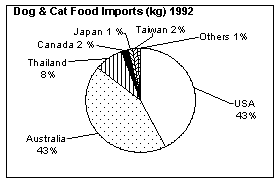
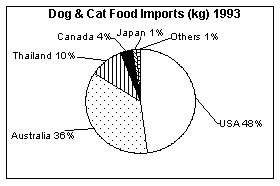



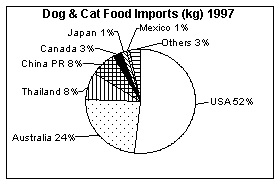
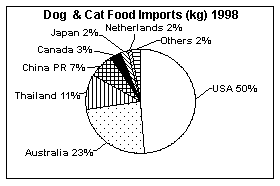

Source: HKCSD
1.4 Canadian Position

Source: HKCSD
| Year | HK$'000 | Growth Rate | kg | Growth Rate | HK$ / kg |
|---|---|---|---|---|---|
| 1992 | 1081 | 0 | 152014 | 0 | 7.11 |
| 1993 | 2069 | 91.40% | 358438 | 135.79% | 5.77 |
| 1994 | 1770 | -14.45% | 353335 | -1.42% | 5.01 |
| 1995 | 2695 | 52.26% | 400630 | 13.39% | 6.73 |
| 1996 | 4351 | 61.45% | 511593 | 27.70% | 8.50 |
| 1997 | 3457 | -20.55% | 409541 | -19.95% | 8.44 |
| 1998 | 3268 | -5.47% | 429821 | 4.95% | 7.60 |
| 1999 | 3024 | -7.47% | 378486 | -11.94% | 7.99 |
| Total | 21715 | 2993858 | 7.25 |
Source: HKCSD
From 1992 to 1999, the total value of the dog and cat food imports from Canada was HK$21.72 million; it represented the total of 3 million kilograms. This quantity of Canadian products took up a 3% of the market share.
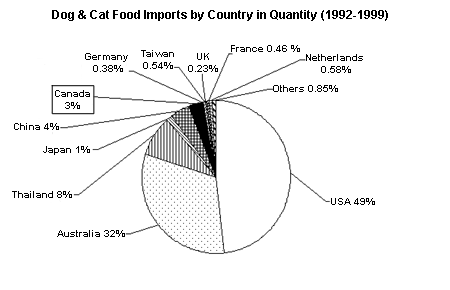
Source: HKCSD
1.5 Sub-Markets
In Hong Kong, dog and cat foods are distributed between two types of sub markets, these include:
A. Pet Specialty Market
B. Consumer Retail Market
At present, the pet specialty market represents an estimated 45% of total dog and cat food sales, and the consumer retail market shares the remaining part of 55%.
By Hong Kong regulations, animal trader license must be needed to run the business in dog and cat trading, and boarding establishment license is wanted to board animals at business establishment. There were 441 animal trader licenses and 14 boarding establishment licenses were issued at 1998. The pet specialty market can be included the following five types of organizations which specialize solely in pets and focus to pet care:
- Dog and Cat Shops
- Pet Supplies Stores
- Dog and Cat Breeders / Boarding
- Veterinary Clinics
- Society for Prevention of Cruelty to Animals (SPCA) and Care Animals Association (CAA)
Dog and cat shops together with pet supplies stores account for approximately number of 280 registrants, they occupy 80% of the total pet specialty market. Fourteen dog and cat breeders/boarding represent 4%, while the veterinary clinics and SPCA/CAA have the remaining 16% market share with 55 establishments.
The consumer retailer market consists of supermarkets and convenience stores. There are two major supermarket chains, which are Park N' Shop and Wellcome with more than 400 total locations in Hong Kong. 7-11 and O.K. are with the total up to 500 chains in convenience store sector.
The fish and bird foods are dry foods account for very little on weight basis; distributors of these pet foods are usually the pet stores themselves, therefore the market is very fragmented. Other pet variety such as rabbits, hamster, chinchilla, lizards and snakes are increasingly popular in Hong Kong, but the overall number remains insignificant.

Source: Ease Pundit Limited
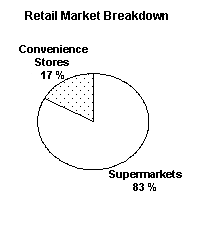
Source: Ease Pundit Limited
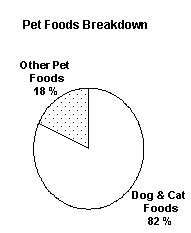
Source: Ease Pundit Limited
In Hong Kong, dog and cat foods account for more than 82% (by weight) of total pet food consumed.
2.0 Trade Segmentation
2.1 Imports, Re-exports, Domestic Exports
Imports
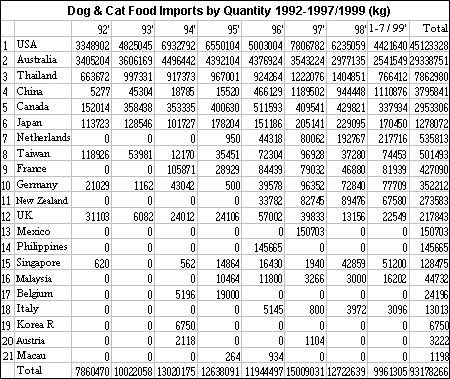

Source: HKCSD
Dog and cat foods have 82% of the pet food market, the others like fish food and bird food have only 18%, so the dog and cat foods can be count to the major consideration in Hong Kong pet food market. Also, the fish and bird foods do not have any statistic figures can be found, the data regarding to the fish and bird foods are according to the key players within the industry.
The official statistic of dog and cat food imports should be reduced by about 10% to reflect the actual import levels as importers typically declare other pet supplies as pet food shipment.
| At Current Market Prices | At constant (1990) Market Prices | |||
|---|---|---|---|---|
| HK$ | Year-on-year % Change |
HK$ | Year-on-year % Change |
|
| 1993 | 154,331 | - | 118,748 | - |
| 1994 | 169,488 | 9.8 | 122,018 | 2.8 |
| 1995 | 178,304 | 5.2 | 125,126 | 2.5 |
| 1996 | 183,841 | 3.1 | 121,814 | -2.6 |
| 1997 | 203,275 | 10.6 | 127,317 | 4.5 |
| 1998 | 194,143 | -4.5 | 120,898 | -5.0 |
| 1999 | 187,541 | -3.4 | 123,071 | 1.8 |
From the figure of per capita GNP in 1993-1999 can find out the influence of consumption power to pet food. At 1997, dog and cat food imports had a value HK$147 millions; the per capita GNP was HK$203,275. However, the GNP dropped to HK$194,143 or the change rate was minus 4.5% at the next year, the imports value was down 15% to HK$117 millions.
Re-Exports
The trend of re-exports of dog and cat food basically follows that of imports, but in a much more drastic manner. The volume fluctuated 3 to 4 times from 1993 to 1996.
A peak in 1994 showed the highest level of regional distribution as imports reached 13,000 metric ton.
The large dip from 1994 to 1996 indicated an overall volume decrease caused by reduced imports / local consumption.

Source: HKCSD
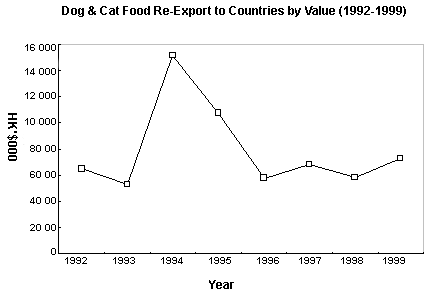
Source: HKCSD
In 1992, about 80% of re-exports were directed to Macau and China, and 1993 to 1995 the 80% was done by Philippines and Macau, reflecting Hong Kong's position as a key location for pet food transshipment.
1993 to 1996 experienced much regional distribution activity as Hong Kong distributors targeted more re-export destinations like UK, Netherlands, Thailand, Japan, South Korea and even North Korea.
1996 and 1997 saw an overall decrease of trade activities for dog and cat food, affecting re-exports.



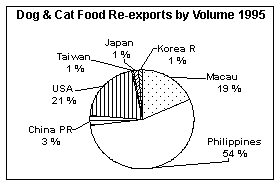



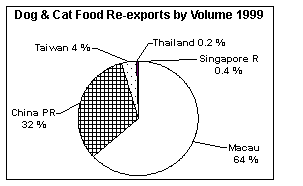
Source: HKCSD
Philippines and USA re-exports increased 3 times and 15 times by value respectively in 1994 and reduced somewhat in 1995, after then there was no records of re-exports from these two countries.
Re-exports to China have been erratic in the past 5 years as pet ownership fluctuated a great deal and branded products have their factories starting to supply in local market.
Macau re-exports have a steady growth about 8-15% yearly. Taiwan had a big reduction in 1994-1995 then back to the level as 1992-1993.
China and Macau again dominated the re-export destination market.
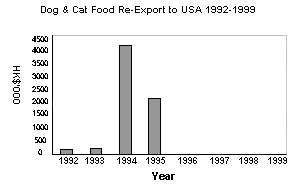
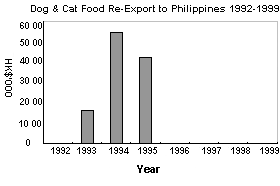
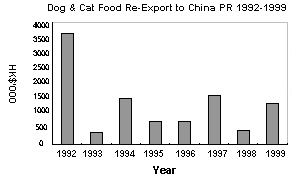
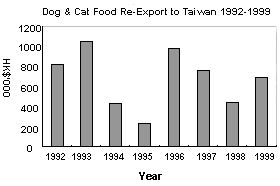
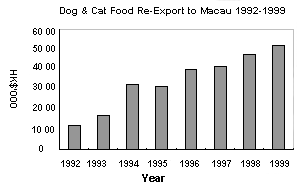
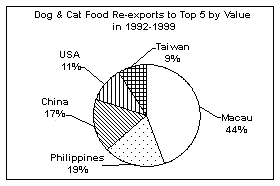
Source: HKCSD

Source: HKCSD
Re-export value varied a great deal as well:
* The value decreased from HK$8.8/kg (FOB) to HK$7.0/kg in 1994/95, which was he result of expanded regional distribution of medium and low-end pet foods at reduced pricing to countries like Philippines.
* Re-export values drastically increased to Hk$13-14 in 1996 and 1997 as suppliers like Iams expanded into regional markets, especially China.
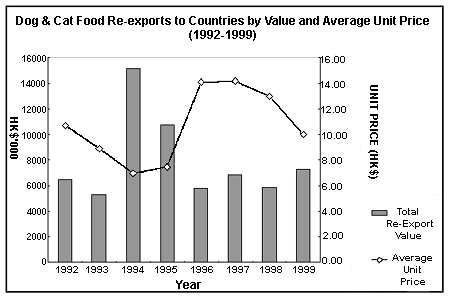
Source: HKCSD
Domestic Exports
Hong Kong has manufacturers doing accessories for pets, but pet food factory does not exist to do the full processing of pet food product. The dog and cat food exports are some kinds of pig and cattle's by products or treats for dog and cat.
From 1992 to 1999, the exports total value is HK$2.2 millions, and China takes up to almost 90% to HK$1.96 millions.
The domestic exports include other repacked quantities, for example Iams cat food is repacked into smaller bags and sold to Guangdong. Such pet food packing is not available in Hong Kong market.
| Year | Quantity (MT) |
Value (HK$'000) |
|---|---|---|
| 1992 | 7.30 | 10.00 |
| 1993 | 79.00 | 157.00 |
| 1994 | 38.20 | 82.00 |
| 1995 | 11.80 | 132.00 |
| 1996 | 74.60 | 1003.00 |
| 1997 | 36.00 | 775.00 |
| 1998 | 0.00 | 0.00 |
| 1999 | 2.00 | 50.00 |
Source: HKCSD
| Country | Quantity (MT) |
Value (HK$'000) |
FOB-Value (HK$/kg) |
|---|---|---|---|
| Macau | 7.30 | 10.00 | 1.38 |
| Philippine | 114.90 | 218.00 | 1.90 |
| China PR | 119.80 | 1963.00 | 16.39 |
| USA | 0.03 | 3.00 | 96.77 |
| Korea Dem PR | 0.80 | 18.00 | 22.50 |
Source: HKCSD
There is no fixed pattern for domestic pet food exports, as it is shown that the erratic pattern is mainly because China's (or Guangdong's) demand is unstable, and also the effect of inconsistent re-export volume into the country.
2.2 Local Demand Consumption
There is less than 13% in value of the dog and cat food imports is to be the re-exports in 1992-1999.
The local consumption of dog and cat food amount to 13 million kilograms and the pet food consumption were about 16.5 million kilograms with the value at HK$146.6 millions in 1999.
More than 82% of the pet food was dog and cat food, others pet foods were for fish, birds, hamsters, and other small animals.
Almost all local demand is supplied through imports in all kinds of pet foods. The two major supermarket chains, Park N' Shop and Wellcome, are the major local repacker and quantity is insignificant.
Overall, pet food demand is declining and is expected to remain flat or continue to fall in the future.

Source: HKCSD

Source: HKCSD
Dog and cat food in Hong Kong are separated into two categories, they are popular and premium. The market share of each brand is depicted by the status, of whether it is popular or premium.
At the marketing channel for each type of pet food is different, so is the overall segmentation.
Popular brands include Purina, Pedigree, Chum, Top Dog, etc for dog, and Purina Cat Chow, Whiskas, Top Cat, etc for cat. Popular brand pet foods are distributed primarily through supermarket chains, with very few through pet supply stores and pet shops. Supermarkets chains like Park N' Shop and Wellcome in Hong Kong, they have their own brand named products both for dog and cat, the products are repacked from bulk packs importing from other countries like USA, Thailand, Philippines and China.
Premium products include Iams / Eukanuba, Hill's Science Diet, Natures Recipes, etc, for both dog and cat. Almost premium pet foods are exclusively distributed through pet shops, pet supply stores, veterinary clinic, and very rarely in supermarkets or convenience stores.
Iams dominates the premium market segment, with more than 60% market share, followed by Hill's at approximate 20%, and Nature's Recipes. On the popular brand, Effem Food with its Pedigree and Whiskas is the predominant market leader, it get more than 70% market share.

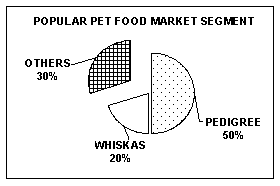
Source: Ease Pundit Limited
2.3 Market share - By Food Type
There is no accurate figures on the populations of dog and cat in Hong Kong. The figures can be estimated base on the work of Agriculture, Fisheries and Conservation Department, which give the licenses to dogs and eliminate the stray dogs. The estimated figure to the populations of dog can be more than 300,000 in 1999, about one half of this numbers are dogs with licenses and the other half are the dogs without licenses and stray dogs. The populations of the cat may be the same numbers of the populations of dog, because it is common for people adopting a cat try to get rid of the mice out from their premises.
Since the per capita pet consumption of dog food ranges from 2 to 5 times that of cat food, the overall split between dog and cat food in Hong Kong is approximate 1 to 2 for 34% to 66%.
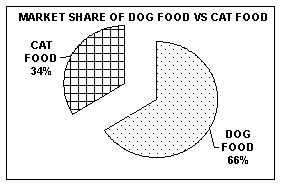

Source: Ease Pundit Limited
Pet food can be categorized to dog food, cat food, fish food, bird food and others, their shares in the pet food market are 54%, 28%, 14%, 2% and 2% respecttively.
The ratio of dog and cat food to other pet food is about 82% to 18%, among the other pet food, more popular are foods for fish, birds hamsters and rabbits. Others are insignificant.
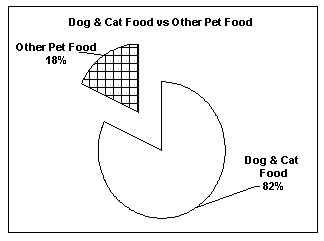
Source: Ease Pundit Limited
Dog and cat food has two type of manner in processing, it is to make the product in a can (wet food) or to do in dry pellet style (dry food). Wet food is generally lower priced and yields higher profit margins, also the cost of the floor area for the wet food is lower than the dry food compare with the size of the product. Therefore supermarkets being very competitive at present, choose to focus on wet food, which would allow more room for price reduction. Dry food is known to be more nutritious and better for pet's health, which is the focus of most pet shops. Therefore, more dry foods are sold in pet shops and pet supply stores.
So, segmentation of dry and wet foods for dogs and cats depends to a great extent on the type of product and distribution channel.
Popular brands like Pedigree and Whiskas are distributed in supermarkets. The ratio of dry to wet food is 35% against 65%.
Premium brands like Iams, Hill's Science Diet, Natures Recipe, etc, are distributed in pet shops and pet supply stores, also veterinary clinics. The dry to wet food ratio is 65% to 35%.
The overall dry to wet food ratio is therefore approximately at 1 to 1.

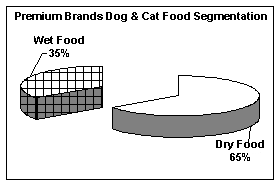
Source: Ease Pundit Limited

Source: Ease Pundit Limited
2.4 Major Brands and Respective Market Shares
Major branded products can be easily found in Hong Kong, they share up to 85% of the pet food market.
Pedigree / Whiskas, Friskies, Purina and Iams / Eukanuba are branded products in dog food and cat food.
Hill's Science Diet and Natures Recipe are the brands for dog food only.

Source: Ease Pundit Limited
The ratio of the popular brands to premium brands in the major brands is 57% to 43%.
Therefore, by combining both popular and premium segments, the overall market shares of various brands of dog and cat foods are as the table:
| TYPE | BRANDS | MARKET SHARE (%) | TOTAL |
|---|---|---|---|
| Popular | Effem Products | 38% | 55% |
| Friskies | 9% | ||
| Others | 8% | ||
| Premium | Iams / Eukanuba | 22% | 45% |
| Hill's | 8% | ||
| Natures Recipe | 8% | ||
| Others | 7% |
Source: Ease Pundit Limited

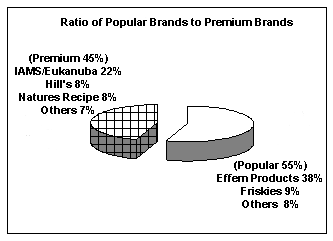
Source: Ease Pundit Limited
2.5 Market Share - By Supplying Countries
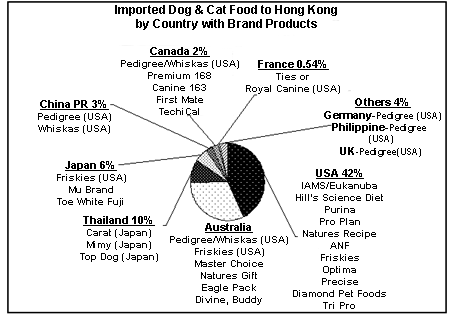
Source: Ease Pundit Limited
An overview of products being imported by countries in 1992-1999, the USA branded products have a cumulative market share of approximately 80% as American multi-nationals produce in a number of countries and export into Hong Kong.
3.0 Distribution And Pricing
3.1 Distribution Channels
In Hong Kong, most pet food importers sell directly to the retail outlets with no distributor in between; some pet supply stores act as an importer on pet food as well as pet accessories and treats.
At present, the supermarket chains have a higher market share, the ratio to pet care is 2 to 1, or 65% to 35% respectively, primarily due to:
1 ) More extensive reach by supermarkets in all locations in Hong Kong;
2 ) Lower pricing at the supermarket level;
3 ) Dogs and cats usually enjoy wet food more, which is the primary focus
of supermarkets.
Typically, supermarkets and convenience stores charge slotting / listing fees for shelf space and suppliers may be expected to pay an extra charge based on the amount of shelf space required. An administrative fee on each item may also be required. Therefore, most popular brands do not have much variety as the premium. The premium brands like Iams, Hill's and Natures Recipe have 4-6 different recipes for each dry and wet product type. Some brands like Mu, which is from Japan, have twelve different recipes.
3.2 Mark-up at Distribution Stage
In Hong Kong, there is no pet food distributor, the pet food importers must do the job of the distributors. Therefore, the average profit margins for importers of pet food items are approximately 20-25%, and retailers 15-20%.
3.3 Pricing and Packaging
In Hong Kong, pet food is a very competitive market. Currently most major brands in the World have been introduced into the small and compact Hong Kong market. Several brands entered the market in 1994-1996, creating more severe downward pressure on price.
Due to the restriction for pet ownership in public housing, an overall trend of dog and cat food pricing has been downward after 1996. Some products, which could not fit to the market, were eliminated in the price war. At this time, prices of both popular and premium brands should be steadier after a declination. Price differences between 1994 and 1997, premium brands declined by 5% and popular brands by 10%.
Examples of pricing and packaging of dog and cat food are listed below:
| Brand | Packaging | Price (HK$) |
|---|---|---|
| Dry food - Hill's Science Diet | 5 lb / bag | 72 |
| 20 lb / bag | 208 | |
| 40 lb / bag | 370 | |
| Dry food - Natures Recipes | 5 lb / bag | 90 |
| 9 kg / bag | 195 | |
| Dry food - Propane | 9 kg / bag | 190 |
| 40 lb / bag | 355 | |
| Dry food - Iams/Eukanuba | 4 lb / bag | 70 |
| 3 kg / bag | 108 | |
| 7.5 kg / bag | 202 | |
| 15 kg / bag | 305 | |
| Dry food - Purina | 4 lb (regular) | 63 |
| 4 lb (lamb) | 80 | |
| 8 lb / bag | 110 | |
| 17 kg / bag | 360 | |
| Dry food - Pedigree | 1.5 kg / bag | 35 |
| 2 kg / bag | 40 | |
| 15 kg / bag | 240 | |
| Dry food - Friskies | 1.5 kg / bag | 30 |
| Wet food - Pedigree | 700 g / can | 15 |
| 400 g / can | 10 | |
| 190 g / can | 6.5 | |
| Wet food - Iams/ Eukanuba | 140 g / can | 15 |
| Wet food - Cesar | 100 g / can | 8.5 |
| Wet food - Top Dog | 400 g / can | 7.8 |
| Wet food - Chum | 700 g / can | 10.5 |
| Brand | Packaging | Price (HK$) |
|---|---|---|
| Dry food - Iams/ Eukanuba | 700 g / box | 52 |
| 3 kg / paper bag | 135 | |
| Dry food - Hill's Science Diet | 4 lb / bag | 85 |
| 10 lb / bag | 165 | |
| Dry food - Whiskas | 500 g / box | 18.5 |
| 1.5 kg / bag | 48 | |
| Dry food - Natures Recipe | 4 lb / bag | 95 |
| Dry food - Purina' Cat Chow | 510 g / box | 17 |
| Dry food - Nutro | 3 lb / bag | 85 |
| Dry food - Friskies | 500 g / box | 19 |
| Wet food - Iams/ Eukanuba | 85 g / can | 5.5 |
| 3 oz / can | 8 | |
| Wet food - Whiskas | 85 g / can | 5.5 |
| 190 g / can | 6 | |
| 400 g / can | 9 | |
| Wet food - Friskies | 85 g / can | 5.5 |
| Wet food - Hill's Science Diet | 155 g / can | 10 |
| Wet food - Natures Recipe | 156 g / can | 11 |
| Wet food - Premium 168 | 85 g / can | 5.5 |
| Wet food - Nutro | 85 g / can | 6 |
| Wet food - Mimy | 95 g / can | 5 |
| Wet food - Carat | 90 g / can | 5 |
| Wet food - Triumph | 85 g / can | 5.5 |
| Wet food - Tresor | 100 g soft pack | 7 |
| Wet food - Kitty's Superme | 100 g soft pack | 5.9 |
| Wet food - Favourits Premium | 100 g soft pack | 14 |
| Wet food - Kitty's Dinner | 170 g / can | 3.5 |
3.4 Recommendation for Promotional Activities
Constant promotion and advertising are necessary to maintain and expand market share. Pet food importers have to provide special price reductions from time to time to ensure they retain their respective market shares, price is the critical factor in the severe competition market.
"My Pet" and "Canine World" are monthly magazines for pet owners in Hong Kong; the pet food traders to promote branded products commonly use them.
Retailers, normally the supermarket chains, will collect a promotion fee, and they produce in-store promotional material, include a product in its promotion flyers and discount coupons.
In Hong Kong, it has three dog shows every year and one time for the cats. These events are the good opportunity to introduce the pet's products to the pet owners.
4.0 Packaging and Labeling
4.1 Local Legal Requirements for Packaging and Labeling
Hong Kong does not have any legal requirements in regards to the packaging of pet foods. For the benefit of the consumers, the Food and Drugs (Composition and Labeling) Regulations can be applied to the pet foods. The regulations require food manufacturers and packers to label products in a prescribed, uniform and legible manner.
The following information is required to be marked on all prepackaged food except for 'exemption items' as provided in Regulations. Prepackaged food means food packaged in such a way that the contents cannot be altered without opening or changing packaging and the ready for presentation to the ultimate consumer or a catering establishment as a single food items.
1. Name of the Food
a) Prepackaged food shall be legibly marked or label with its name or designation.
b) The food name should not be false, misleading or deceptive but should serve to make the nature and type of food known to the purchasers.
2. List of Ingredients
a) Preceded by an appropriate heading consisting of the words "ingredients", "composition", "contents" or words of similar meaning, the ingredients should be listed in descending order of weight or volume determined when the food was packaged.
b)If an additive constitutes one of the ingredients of a food, it should be listed by its specific name or by the appropriate category (e.g.Preservative, artificial sweetener, etc.) or by both name and category.
3. Indication of "best before" or "use by" date
Prepackaged food shall be legibly marked or labeled with the appropriate durability indication as follows:
a) a "best before (in Chinese characters as well) date; and
b) in the case of prepackaged food which, from the microbiological point of view, is highly perishable and is likely, after a short period, to constitute an immediate danger to human health, a "use by'(in Chinese characters as well) date.
The words "use by" and "best before" in English lettering and Chinese characters followed by the date which specific properties of the food can be retained, to indicate the shelf life of the food. The "use by" and "best before" date should be shown either in Arabic numerals in the order of day, month and year (or month and year in certain circumstances) or in both the English and Chinese languages.
4. Statement of Special Conditions for Storage or Instruction for Use
If special conditions are required for storage to retain the quality, or special instructions are needed for prepackaged food use, a statement should be legibly marked on the label.
5. Name and Address of Manufacturer or Packer
Prepackaged food shall be legibly marked or labeled with the full name and address of the manufacturer or packer, except under the following situations:
a) The package is marked an indication of the country of origin, and the name and address of the distributor or brand owner in Hong Kong. The address of the manufacturer or packer of the food in its country of origin has been submitted in writing to the Director of Health.
b) The package is marked or labeled with an indication of its country of origin and with a code identifying the manufacturer or packer in that country, and particulars of the code and of the manufacturer have been submitted in writing to the Director of Health.
6. Count, weight or Volume
The food label should include the numerical count or net weight or net volume of the food.
7. Appropriate Language
The marking or labeling of prepackaged food can be in either the English or Chinese language or in both languages, If both the English and Chinese languages are used inn the labeling or marking of prepackaged food, the name of the food and the list of ingredients shall appear in both languages.
4.2 Consumer Preference
Packaging for pet foods come in a variety of material types and sizes. The most popular material and sizes for dog and cat foods, and their respective market shares are as follows:
| Material | Market Shares |
|---|---|
| Paper Bag (dry food) | 50% |
| Metal Can (wet food) | 50% |
| Sizes | Market Shares |
| 2 kilograms | 45% |
| 15 kilograms | 25% |
| Others | 30% |
Source: Ease Pundit Limited
5.0 Consideration for Market Entry
Foreign firms and individuals are allowed freely to incorporate their operations in Hong Kong, to register branches of foreign operations, and to set up representative offices without discrimination or undue regulation. There is no restriction on the ownership of such operation. Company directors are not required to be citizens of, or resident in Hong Kong. Reporting requirements are straightforward and not onerous.
Hong Kong has no special legislation regarding agents and distributors. Virtually anything which both sides can agree to and put into a written contract is acceptable and enforceable, including restrictions on territory and a grace period for termination of the agreement.
While not required y Hong Kong law, the more complex the contract, the more likely one will benefit from legal counsel in drafting the text.
5.1 Suggested Business Practices
Hong Kong is an amalgam of traditional Chinese society, and the most modern technological elements from the west. It is a society which practices religious and racial tolerance. Above all, it is a society that emphasizes hard work and success.
There are few cultural problems for Canadians doing business in Hong Kong. Canadians should be aware that Hong Kong people tend to be more acquaintances are addressed as Mr. or Ms. unless they state that first name should be used. Business cards are exchanged frequently and the exchange should be fairly formal.
It will help to be familiar with local customs, but it is not vital. As this is very cosmopolitan city, the people as well aware and tolerant of different customs. Business contacts should be treated the same as a formal relationship in the Canada. Western business attire is appropriate.
5.2 Rules and Regulations
Hong Kong pursues a free market philosophy, and there is minimum government interference with corporate initiative. The territory welcome foreign investment. It offers no special incentives nor does it impose disincentives for foreign investors. Hong Kong's well established rule of law is applied consistently and without discrimination. There is no distinction in law or practice between investments by foreign-controlled companies and those controlled by local interests.
There are no direct subsidies to domestic industries and, as a duty free port, no tariff barriers. There is no discrimination against foreign investors either at the time of initial investment or afterwards. There is no capital gains tax nor are there withholding taxes on dividends and royalties. Profits can be freely converted and remitted. Foreign-owned and domestically owned firms are taxed at the same rate, 16.5% of profits. There are no preferential or discriminatory export and import policies which affect foreign investors.
Most imports are free of restrictions, except for those maintained for health, safety, environmental protection, or security reasons. Importers of reserved commodities, including rice and frozen meat, must obtain an importer's license before they can import these commodities.
With few exceptions, a trade declaration must be lodged with the Customs and Excise Department within 14 days of importation in respect of each consignment of goods imported into Hong Kong.
According to a trade coordination policy, Hong Kong will not be required to adopt Chinese trade sanctions against other countries, unless the sanctions are based on a United Nations decision.
6.0 Pet Food Importers and Agents:
| BRAND | IMPORTER / AGENT |
|---|---|
| ANF Advance Nutrition Formula | Pet Equipment Supply Ltd. Tel: 24076303 Fax: 24076257 |
| Master Choice Nature's Gift Snappy Tom |
Hopeworth International (HK) Co. Ltd. Tel: 21726732 Fax: 21726763 |
| Tiesor Natural |
Long Term Development Co. Tel: 24883288 Fax: 24794429 |
| Eagle Pack Divine |
Tan Kwai Yuen Kennel Tel: 24884887 |
| Royal Canin Tce White Fuji Premium 168 Canine 163 |
Pet's Goods Tel: 24803395 Fax: 24892071 |
| Strong Dog Feli Cat Nature's Friend |
Kam Fai Pet Products Factory Tel: 26691862 Fax: 26760082 |
| Natures Recipe | The Natural Power Company Tel: 24650028 |
| Purina | Waylun Trading Company Tel: 26778033 Fax: 26776211 |
| Optima Natra Nuggets |
Mago Pet Supplies Co. Tel: 23830082 Fax: 27165325 |
| Eukanuba / Iams | Iceville Ltd. Hong Kong Tel: 25558402 |
| Pro Plan | Jazz Co. Tel: 24741462 Fax: 24884797 |
| Frist Mate | Dor Bo Pet Supplies Ltd. Tel: 28341992 |
| Hill's Science Diet | Universal Pharmaceutical Lab. Ltd. Tel: 256294.5 Fax: 25625084 |
| Precise | New World Pet Supplies Company Tel: 91076939 Fax: 24885331 |
| Pedigree / Whiskas | Effem Food HK Ltd. Tel: 27217477 |
| Natra Nuggets Professional Premium Edge Diamond Food Formulas |
Petlover & Pet Care Co. Tel: 24822540 Fax: 24716479 |
| Rokus | Pet's City Products Co. Tel: 27826188 Fax: 27700983 |
| Tri Pro | Luen Kiu Company Tel: 23047812 Fax: 23047655 |
| Friskies | Nestle' Hong Kong Tel: 21798888 |
| TechniCal | Evergreen Pet Supplies Ltd. Tel: 24191988 Fax: 24191652 |
| Pro Vitamin | Swire Group Tel: 23106161 |
| Nutro-Max | PED Group (HK) Ltd. Tel: 27543628 |
| Avo-Diets | Well Tech Development Ltd. Tel: 25371133 |
| Date Modified: 2001 05 11 | Important Notices |